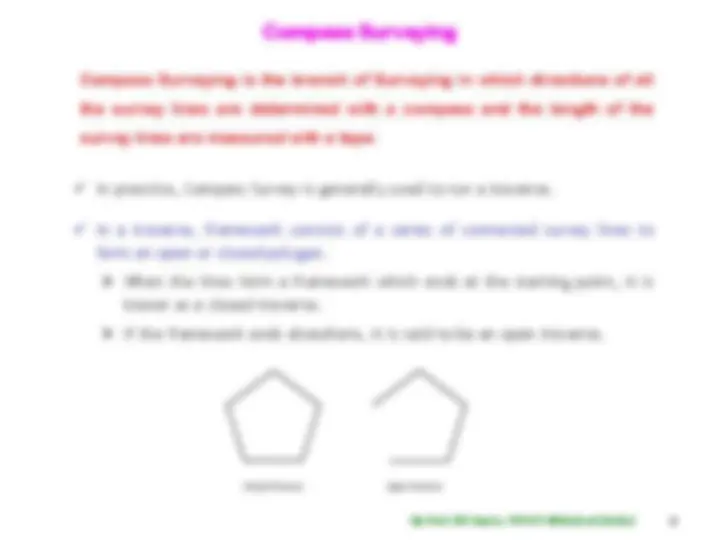













































Study with the several resources on Docsity

Earn points by helping other students or get them with a premium plan


Prepare for your exams
Study with the several resources on Docsity

Earn points to download
Earn points by helping other students or get them with a premium plan
Community
Ask the community for help and clear up your study doubts
Discover the best universities in your country according to Docsity users
Free resources
Download our free guides on studying techniques, anxiety management strategies, and thesis advice from Docsity tutors
This document, authored by Prof. RD Gupta from MNNIT Allahabad (India), provides an in-depth exploration of compass surveying. Topics covered include the designation of bearings, magnetic declination, compass surveying techniques, and the calculation of bearings from included angles. The document also discusses instruments used in compass surveying, such as the prismatic compass and its parts.
Typology: Lecture notes
1 / 51

This page cannot be seen from the preview
Don't miss anything!












































➢ Designation of Bearings and inter-conversion, ➢ Included angles from bearings and vice versa, ➢ Magnetic declination, local attraction, ➢ Temporary adjustments and parts of prismatic compass; ➢ Vernier Theodolite, measurement of horizontal angles: repetition method & reiteration method, traversing by compass and theodolite, computations of traverse coordinates, traverse adjustment; Total Station
Compass Surveying is the branch of Surveying in which directions of all the survey lines are determined with a compass and the length of the survey lines are measured with a tape. ✓ In practice, Compass Survey is generally used to run a traverse. ✓ In a traverse, framework consists of a series of connected survey lines to form an open or closed polygon. ➢ When the lines form a framework which ends at the starting point, it is known as a closed traverse. ➢ If the framework ends elsewhere, it is said to be an open traverse.
Location of a Point by Distance and Direction The direction of a line is defined by a horizontal angle with respect to a reference line. ✓ This reference line is known as Meridian. ✓ The horizontal angle measured with respect to reference line (i.e. meridian) is termed as Bearing. In relative direction, the reference line does not remain fixed over a period of time.
✓ True Meridian through a point is the great circle passing through the point, geographical North and South poles. ✓ Thus, true meridian may be considered as a plane passing through the point on the surface of Earth and containing the axis of rotation of the earth. ✓ The direction of true meridian through a point is established by astronomical observations. ✓ The true meridian does not change with time.
Three types of Bearings:
✓ True Bearing or Azimuth of a line is its horizontal angle from the true meridian, i.e. Geographical North. ✓ Arbitrary Bearing of a line is the horizontal angle which it makes with any arbitrary meridian ✓ The horizontal angle which a line makes with the magnetic meridian is called Magnetic Bearing.
Thanks to all of You Any Questions!